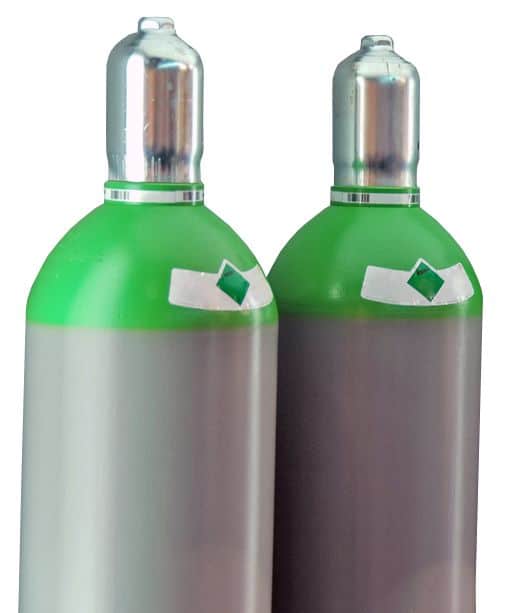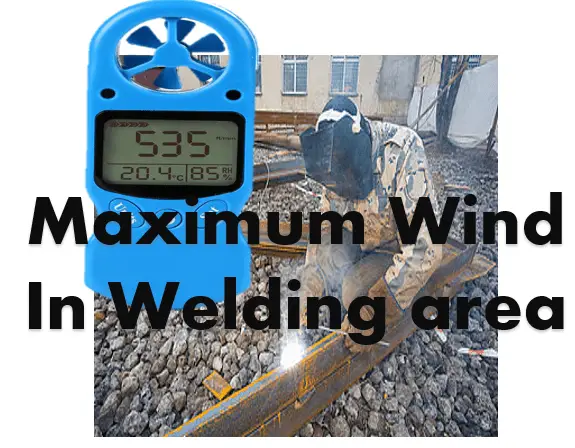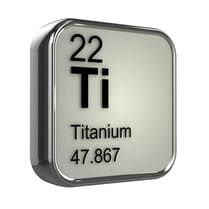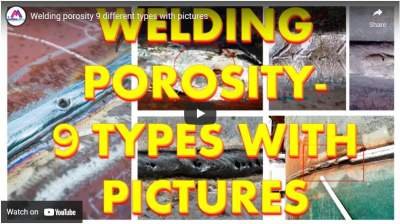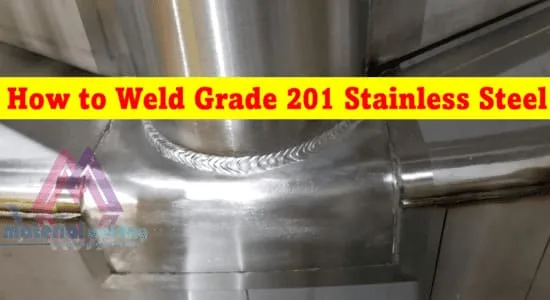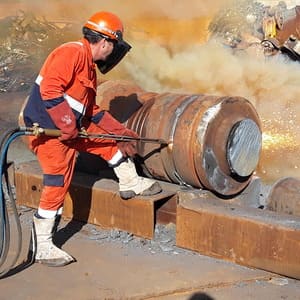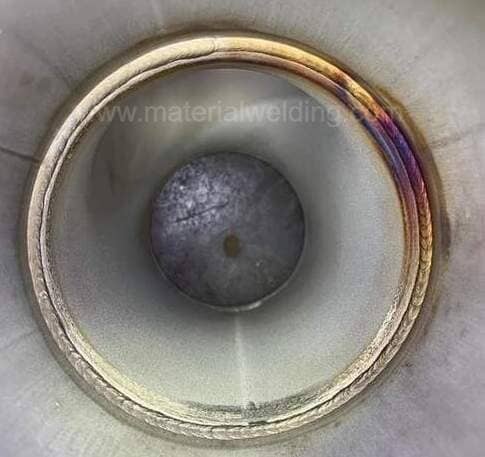What is Gas shielding in welding?
During the welding operation, the air in the welding region is displaced by a shielding gas (either externally supplied or generated by burning of coating from the electrode) in order to avoid contamination of the molten weld pool.
This weld contamination is produced mostly by nitrogen, oxygen, and water vapor present in the air. For example, nitrogen in solidified steel weld decreases the ductility and impact strength of the weld. In large amounts, nitrogen creates weld porosity. Similarly, oxygen can react with the metal and create metal oxides or compounds which can create inclusions.
Oxygen can also combine with carbon to form carbon monoxide (CO). Hydrogen from electrode coating moisture or, present in water vapor and oil, combines with either iron or aluminum creates porosity. It can also result in Underbead weld cracking.
To avoid all these issues related to contamination of the weld pool, shielding gases are used for shielding.
Click here to know about various shielding gases and their purposes.
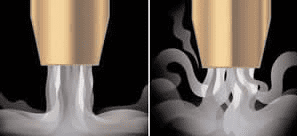
What is Trailing gas?
In trailing a gas is used to give a protective blanket that cover weld pool & surrounding. Trailing is extensively used for Titanium welding where the solidified weld can still react with atmospheric oxygen to create titanium oxide.
For example, for titanium alloys and stainless steels welding, trailing gas is used to protect the weld from oxidation until it has cooled to a safe temperature.
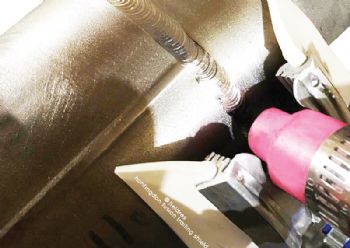
Trailing Shields (an auxiliary attachment with the tig torch) as shown in the above figure are connected to the inert gas cylinder or line, allowing the gas to give a blanket to the weld. On both sides of trailing pads, silicon covers prevent the escape of the trailing gas and give full protection to the finished weld until it cools in an inert gas environment.
During forward movement of the welding torch after finishing weld, the finished weld is shielded by a trailing inert gas until the welding temperature falls below its oxidation temperature. Once the weld cool below the oxidation temperature, there is no further risk to the weld oxidation.
What is Gas Purging?
Weld purging is the process of removing the oxygen, nitrogen, water vapor, and any other gases or vapors from the vicinity of the welding joint root, which may be detrimental to a welding joint as it is being welded and immediately after welding. Purging is chromium base alloys such as stainless steel and Cr-Mo alloys becomes mandatory when nominal chromium content is more than 2.25%.
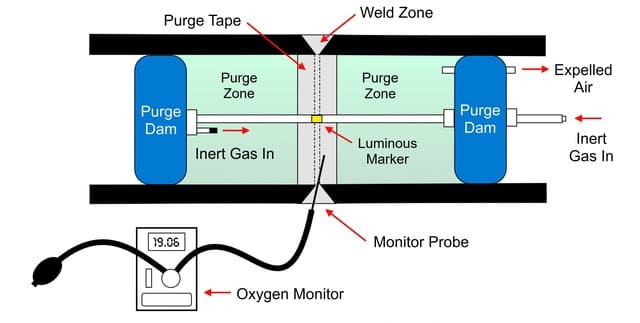
Reactive metals such as austenitic Stainless steel, magnesium alloys, titanium alloys, duplex stainless steels, tantalum, and zirconium can easily get contaminated (oxidized) when they are hot and oxygen or hydrogen sources (air, moisture, oxygen, hydrogen, high humidity) is present in the vicinity.
This can result in the oxidization or embrittlement of the materials and hence the weld needs to be scrapped. Apart from the above, if the contamination is not severe, still this can degrade the material corrosion resistance and the mechanical properties.
Purging of the weld is mandatory when welding reactive metals such as stainless steel, titanium, tantalum, and magnesium alloys. Purging must be carried out for the root run and until the hot pass (2nd pass) is completed.
Continuation of purging gas after completion of root run is recommended until the hot pass is finished. this is because when we weld the hot pass, weld metal on the root side will be still hot enough to get oxidized. For highly reactive materials sometimes it is suitable to continue purging until the weld is completed.
Oxygen analyzer for welding (O2 Purge Meter)
An oxygen analyzer for welding (O2 Purge Meter) is used to verify the oxygen content in the shielding gas by sampling and testing it. Controlled oxygen content in the shielding/ purging gas boosts the welder’s confidence to achieve a quality weld.
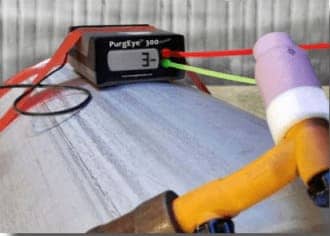
Measurement of gas purge quality
Gas purging quality can be checked based on the discoloration of the metal after welding. Discoloration charts are available in the market and they show the discoloration resulted due to oxygen contamination when welding titanium or stainless steel. So, measurement of oxygen content is important and this can be done using an instrument called an oxygen meter or oxygen sensor (oxygen concentration monitoring system).
When buying an oxygen meter it is important to consider the sensitivity level of the instrument as you will find many different types with varying sensitivity in the market. For best result sensitivity of 1 ppm is sufficient for welding applications. The maximum oxygen content of 0.5% or 5000 ppm in the purging gas shall be ensured before starting the weld.
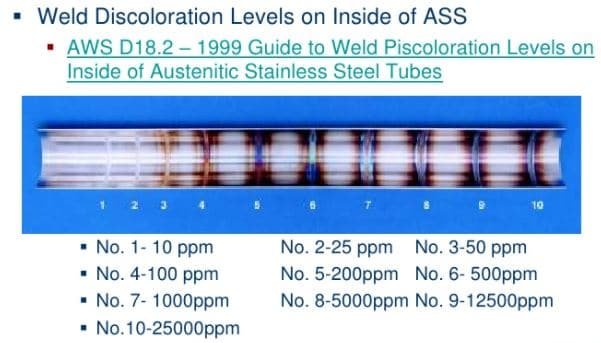
For achieving the best quality welds with high corrosion resistance and mechanical characteristics, it is important to use the shielding & backing gases of very low oxygen levels. When we consider backing gases for root protection, the maximum oxygen content should be 20 ppm.
Hence, it is a must to check the level of oxygen in backing gas using an oxygen meter, prevent any contamination during purging, and follow best engineering practices.
